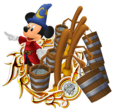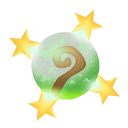Magic
Gawrsh, aren't we here because of the picture?
| |
|---|---|
| This article needs some images!
Please upload a picture or two. | |
Oh no! The water! I'm in big trouble if I don't fetch it!
| |
| This article requires cleanup or improvement.
Please help out by editing this page. Please see the Manual of Style and editing help before getting started. | |
Magic is both a recurring skill and a stat parameter appearing in the Kingdom Hearts series.
Magic is one of two forms of basic offense that Sora and many other characters can perform, the other being weapon-based attacks; although the use of magic is limited by the character's remaining MP, it is, in most cases, perceptibly more powerful than physical attacks, as well as capable of inflicting elemental damage. Party members who excel with magic include Donald Duck, Jack Skellington, and Zexion. Most summoned characters will use some form Magic as their primary form of attack. Summoning is regarded as a form of magic in the original Kingdom Hearts and in Kingdom Hearts: Chain of Memories, but is instead tied to the Drive Gauge in Kingdom Hearts II, in which the number of summons is reduced from six to four.
Magical power is implied to be related to the user's intelligence, as noted by the descriptions of the Dream Rod and Struggle Wand, as well as by the name of the Wisdom Form. Unlike standard combat, which seems to be able to be mastered by practice alone, it appears that magic must be taught, learnt, and studied. Additionally, magic is shown to have various non-combat applications, including travelling between worlds and even through time, as evidenced when Merlin transports the party from Hollow Bastion to Disney Castle and then opens the door to Timeless River, and to be broken when the caster is defeated, as evidenced when Maleficent's thorns disappear following her defeat in dragon form.
Magic is often associated with the colour blue, in which MP is shown in the status bar. In Kingdom Hearts, there was an additional gold bar called overlapping the blue MP Meter to represent MP Recovery, and which could be used as additional MP; in Kingdom Hearts II, however, it does not appear, and, upon expending all of his MP, Sora must wait for the MP gauge to be fully refilled before he is able to cast magic again.
MP may be recovered by inflicting damage enemies; by stepping into a Save Point and allowing the MP gauge to refill; by the use of an Ether, Mega-Ether or Elixir; by the use of a Tent (available in Kingdom Hearts II) or a Cottage (available in Kingdom Hearts); or by picking up the bubble-like MP Orbs dropped by enemies and by the wisps appearing in the Underworld. The abilities "MP Haste" and later "MP Hastera" and "MP Hastega" increase the rate at which MP is recovered. Additionally, "MP Rage" allows magic to be recovered whenever a character takes damage.
Magic-heavy playing styles are considered to be among the more difficult to use, owing largely to the attention that must be paid to elemental differentiation, as some enemies will not be harmed and may even be healed when attacked by certain elements, and the clear limitation imposed by possessing a finite amount of MP, which is only partially remedied by a large stock of restorative items, and by abilities such as MP Haste and MP Rage.
Magic Power
The amount of damage caused by an individual spell is governed by the spell's base power combined with either the caster's max MP (in Kingdom Hearts) or magic power (in Kingdom Hearts II and Kingdom Hearts Birth by Sleep) through a set formula, in addition to any elemental strengths or weaknesses possessed by the target of the spell coupled with any abilities that boost the power of certain element.
Most standard magic spells appear in three tiers of increasing power denoted by a particular suffix appended to the end of its name. Base-tier spells bear no special suffix, but set the precedent for the names of other spells of the same element. Second-tier spells generally append "-ra", sometimes dropping the final syllable of the original spell (cf. Blizzard > Blizzara; Reflect > Reflera etc.), whereas third-tier spells will generally append "-ga". Contrary to the schema used in Final Fantasy, Kingdom Hearts uses "-gun" for fourth-tier spells; however, these only appear as Reaction Commands, or in the name of powerful elemental accessories.
A pair of suffixes -gun and -agun, make an appearance in the battles against the Volcanic Lord and the Blizzard Lord, and are seen in fourth-level magic armor. They do not appear to have originated with Final Fantasy titles, in which -ja and -aja are used instead, but rather to be exclusive to the Kingdom Hearts series, though whether or not these are spells is unclear.
Certain abilities may also influence the power of magic, though these generally carry more weight in Kingdom Hearts II, in which the Keyblade, Donald's staves, and Goofy's shields possess innate abilities. Abilities that affect magic include:
- MP Recovery
- MP Haste
- MP Rage
- Fire Boost
- Blizzard Boost
- Thunder Boost
- Magic Lock-On
- Crime & Punishment
- Magic Haste
- Magic Spice
- Master Magic
- Endless Magic
- Leaf Bracer
- Cure Boost
Some party members also possess abilities that mimic the effects of spells, which include the following:
- Healing Herb
- Blazing Fury
- Icy Terror
- Bolts of Sorrow
- Ghostly Scream
- Cure Potion
- Aero Potion
- Dark Shield
- Dark Aura
Some powerful magical abilities, called Limits, may be performed in tandem with a party member, but will drain all of Sora's remaining MP after usage.
Drive Forms
Of Sora's Drive forms, Wisdom Form, Master Form, and Final Form are the best choices for Magic users.
Wisdom Form enables Sora to shoot magic bullets in lieu of his normal physical attacks, enabling combos at a distance but at a reduced power considering the other forms, as only one Keyblade may be used in this form. Only the standard magic powers consume MP, however, and spells may be cast with the greatest speed in this form, which also possesses the quickest MP recovery rate, with Wisdom Form being one of only two ways in which the strongest MP recovery skill, MP Hastega, may be equipped, the other being the Ultima Weapon.
Any magic power used in Master Form will cause a slightly different effect than it normally would, usually incorporating some sort of additional Keyblade attack. Sora will charge forward when casting Fire, and performs a dance-like combo while casting Thunder and will cast a double-Blizzard that goes to either side rather than straight forward. The use of two Keyblades, which combine their magic stats, lends Master form extra spellcasting power, in addition to the Endless Magic ability, which allows magical combos to continue indefinitely, but this disables magic combo finishers entirely. Master form also boasts the second-highest magic recovery rate in automatically equipping the powerful MP Hastera skill.
Sora, in his Final Form, has the strongest magic potential of any party member, despite having the slowest MP recovery of any magic-using drive form. Thanks to the boosts of magic-oriented abilities and the use of two Keyblades in similar fashion to Master Form, Final Form Sora can attack multiple times and with much more power with the amount of magic any other form would require to land one hit. Final Form is able to augment the power of the spells themselves for maximum efficiency, calling upon multiple bolts of lightning, or launching two blasts of ice with a single casting. Although it is the weakest MP recovery skill, Final Form possesses MP Haste, in addition to the very powerful magic-augmenting skill Crime and Punishment.
Trivia
- The suffixes -ra and -ga are only applied to second and third tier spells, respectively in the English, Italian, German and Japanese versions of the Kingdom Hearts games. In the French version, the second form is noted with a plus (+) sign, while the third is noted with an X. The suffix -gun, present in all accessories with that suffix (Firagun Armlet, for instance), is often represented as XX. In the Spanish version, the suffix -ga is noted with two plus signs (++).
Notes and references
See also
- Abilities (Kingdom Hearts)
- Abilities (Kingdom Hearts: Chain of Memories)
- Abilities (Kingdom Hearts II)
- Abilities (Kingdom Hearts Birth by Sleep)
- Sleight
- Enemy card
- Limit Break
- Deck Command
- Shotlock
- Dimension Link


